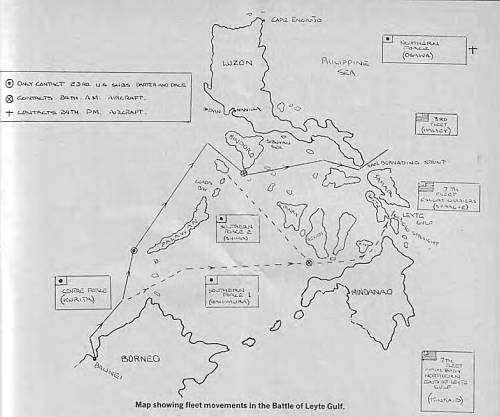- Author
- Collins, Vice Admiral Sir John
- Subjects
- WWII operations
- Tags
-
- RAN Ships
- HMAS Arunta I, HMAS Manoora I, HMAS Kanimbla I, HMAS Westralia I, HMAS Warramunga I, HMAS Shropshire, HMAS Gascoyne I, HMAS Australia II
- Publication
- January 1972 edition of the Naval Historical Review (all rights reserved)
The invitation to write an article for the Naval Historical Review 1972 gives me the opportunity to remind members of the importance of the Battle of Leyte Gulf in Australian history. Every Australian has heard of Trafalgar but few, I feel, know much about Leyte Gulf, which has been described by the British historian, Donald Macintyre, as the biggest sea fight in history.
THE BATTLE CONCERNS AUSTRALIA CLOSELY for it opened the road to victory in the Pacific by reducing the Japanese Navy, which once threatened our shores, to an ineffective remnant. We should know more about this battle and be proud that the Royal Australian Navy took a small but active part in the victory.
This article has been prepared after reference to various accounts of the battle, including Morison’s History of the United States Naval Operations in World War II and Macintyre’s The Battle for the Pacific. Their researches and detailed studies have simplified the task. So complicated is the story that this article can deal with only one of the three big actions, the Battle of the Surigao Strait, the one in which the Australian ships participated.
The story of the battle starts with a great mass of some 600 ships steaming from Manus and Hollandia for Leyte Gulf more than 1,400 miles from Hollandia. These ships carried the troops and equipment for the attack on the Philippine Islands by General Macarthur. They included the Australian Landing Ships Infantry HMAS Kanimbla, Manoora and Westralia, well remembered round our coast in pre-war days, manned by Australians but carrying American troops destined to land on Panoan Island. HMAS Gascoyne and HDML 1074 were in the advanced convoy with the task of surveying the channel while the US Rangers captured the islands at the entrance prior to the arrival of the main body.
This great armada was escorted by the United States 7th Fleet, under Admiral Kinkaid, and included the Australian cruisers HMA Ships Australia and Shropshire and the RAN destroyers HMA Ships Arunta and Warramunga. The escort was augmented by ships from the US Pacific Fleet, including escort carriers. The only Royal Navy ship present was the fast minelayer HMS Ariadne.

While the convoys were assembling and steaming across the ocean, important events were going on to the northward. Manoeuvring off Formosa, Admiral Halsey’s Third Fleet was launching a series of devastating attacks on the Japanese air power based on Formosa and the Philippines. From 10th to 24th October he threw everything he had at them. So successful was he that the Japanese had only 100 operational planes in the Philippines on A Day, hence the freedom from air attacks on passage.
As is so often the case, reports from the few Japanese aviators who did return convinced the Japanese High Command that great damage had been done to the Third Fleet. Tokyo Rose made much of the destruction of the Third Fleet and the authorities appeared to believe their own propaganda. In fact two US cruisers were badly damaged, and minor damage was suffered by three carriers. The Japanese on the other hand lost most of their trained carrier air groups that had been flown to Formosa to operate from shore airfields against the Fleet.
The approach to Leyte Gulf went to plan and, after the usual bombardment and air strikes, the first flight hit the beach at H hour, 10 a.m. on A Day, 20th October 1944.
Macarthur went ashore in the afternoon and made his famous “I have returned” speech. Later USS Honolulu, in the close support area, was torpedoed by a Japanese aircraft which flew in low and escaped detection. The torpedo splash and sub-sequent explosion were observed from Australia but the guns could not be brought to bear in time. The aircraft jinked away and escaped without damage. That was the only effective opposition encountered at sea that day.




